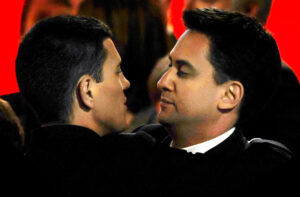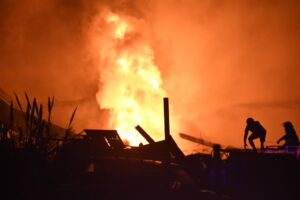On 27 September, Hassan Nasrallah was killed by an Israeli airstrike in Beirut. Barely had the bombs dropped than commentators were already describing Nasrallah’s demise as a transformational moment in Middle Eastern politics. And why not? Benjamin Netanhayhu declared that death of the cleric, a scourge of the Israelis for over 30 years alongside his Iranian sponsor General Abbas Nilforoushan, would change the regional “balance of power” for years to come.
But what if not every dispute in this blood-stained neighbourhood had to be resolved by force? Just a day before the attack on Nasrallah, the Foreign Office, State Department and EU issued a communiqué calling for a three-week ceasefire between Hezbollah and Israel. Joined by a range of other Asian and European states, it would have paved the way to a long-term settlement between the warring sides, and allow displaced civilians to return home.
More to the point, there’s evidence that Israel, Hezbollah and Iran had all agreed to the deal. But amid the rubble of south Beirut, that was soon forgotten.
By any measure, Nasrallah’s death was a shock. But according to Dan Diker, there might have been more to the assassination than meets the eye. As the president of the influential Jerusalem Centre for Security and Foreign Affairs explains, allowing the world to believe that Israel was willing to sign a truce might have been an act of deception. One that led Nasrallah to meet Nilforoushan at Hezbollah’s headquarters — a very un-secret location he believed was safe.
Yet until late September, all attempts to broker a ceasefire in the north had foundered on Hezbollah’s insistence that Israel impose a simultaneous ceasefire in Gaza. While Hamas remained in control of the strip, and Israeli hostages remained in its tunnels, this was a precondition that Israel could never accept.
But in the closing “high-level week” of the UN General Assembly, which began on 22 September, the impasse seemed to shift. A range of world leaders — including Keir Starmer and Emmanuel Macron, alongside Lebanon’s Najib Mikati and Iran’s Masoud Pezeshkian — were all on hand at different times. Netanyahu was in New York too, as was Anthony Blinken and other senior officials from the White House. Feverish talks aimed at securing a ceasefire ensued.
The key to the apparent breakthrough, diplomatic sources say, was a request by Western powers that Iran and Hezbollah agree to drop the Gaza precondition. The Iranians and the Lebanese then spoke, both directly and indirectly, to Nasrallah in Beirut. Long designated a terrorist organisation by most Western nations, including the United States, Hezbollah itself couldn’t join the meetings.
Yet despite his non-attendance, Nasrallah had agreed to a deal by the morning of 26 September. Although Iran and Lebanon didn’t actually sign the communiqué, I understand that the final text had been drafted and circulated to the leadership of both nations. They were also told that key diplomatic players, including Britain and the US, were “on board” with the deal. For its part, Israeli sign-off was “pending” but expected soon. Indeed, sources tell me that the Iranians and Lebanese were then informed by the Americans that Netanyahu was ready to sign.
The same day, Starmer quoted the communiqué almost verbatim in his UN speech, albeit without explicitly acknowledging it. It is fair to say that when Netanyahu himself spoke, on 27 September, he didn’t exactly sound dovish. Talking mere hours before the strike that killed Nasrallah, he warned that Israel would “continue degrading Hezbollah” until its objectives were met — peace on its northern border and the safe return of displaced Israelis to their homes.
Nevertheless, the sources say, those who joined the New York talks believed these aspirations were compatible with a ceasefire, ultimately followed by a negotiated peace. Certainly, after the IDF strike finally happened, one European participant is said to have described it as a “slap in the face” to those who’d worked to stop the violence. Another claimed that Israel’s alleged duplicity had destroyed any sense of trust, noting that the commodity was already in short supply across the Middle East.
The following week, Abdallah Bou Habib, the Lebanese foreign minister, publicly claimed that Nasrallah had indeed agreed to a ceasefire just before he died. But amid the escalating conflict, with Israeli troops by now on the ground in Lebanon, his words didn’t resonate.
I asked the Israeli foreign affairs ministry whether it was true that Israel had encouraged its foreign interlocutors to think it was ready for a ceasefire. It declined to comment. I also spoke to Diker, whose thank tank has advised Israeli governments since 1976, and whose staff includes numerous senior figures from the country’s intelligence, security and diplomatic establishments.
“I think Israel outsmarted Iran and Hezbollah because it knew they were lying about their own desire for a ceasefire,” he says. “Israel beat Iran at its own game of psychological warfare, and made it seem it was ready to agree to a ceasefire while proceeding with a plan to eliminate Nasrallah and fighting on to win.”
Certainly, the Israelis have aggressively pursued their interests elsewhere. That includes a massive cyberattack on key Iranian institutions on 12 October, including its nuclear facilities. According to Abolhassan Firouzabadi, a former secretary of Iran’s Supreme Council of Cybersecurity, “almost every sector of the Iranian government, the judiciary, the legislature, and the executive, has been affected by these cyber-attacks”.
This does not, however, make Iran any less dangerous. When analysts consider worst-case scenarios for expanding conflict across the region, they sometimes cite the potential closure of shipping lanes in the Persian Gulf. That would immediately cut off oil supplies to Europe, and trigger rampant inflation.
Yet the sources I spoke to, who also took part in the New York talks, suggested things could escalate even further. One possibility is that Yemen’s Houthi terrorist group, armed and directed by Iran, might launch a drone or missile against a landmark in the United Arab Emirates. An obvious target is the Burj Khalifa, the world’s tallest building, thereby smashing the “Dubai dream” in an instant.
Earlier this week, Iran’s foreign minister Abbas Araghchi went to Oman to meet Mohammed Abdelsalam, a key Houthi leader. Their meeting was held expressly to discuss a possible Houthi response once Israel has retaliated to Iran’s recent missile strikes. Further down the road, the Islamic Republic could also try to foment an uprising in Jordan by its Palestinian majority, overthrowing the Hashemite monarchy that’s enjoyed peace with Israel since 1994.
The abortive diplomacy in New York, in short, stands in stark contrast to the Israeli vision of a victor’s peace. Yet given Iran’s ability to respond, even in its weakened state, it remains to be seen if Netanyahu’s gambit wasn’t a huge miscalculation.
Disclaimer
Some of the posts we share are controversial and we do not necessarily agree with them in the whole extend. Sometimes we agree with the content or part of it but we do not agree with the narration or language. Nevertheless we find them somehow interesting, valuable and/or informative or we share them, because we strongly believe in freedom of speech, free press and journalism. We strongly encourage you to have a critical approach to all the content, do your own research and analysis to build your own opinion.
We would be glad to have your feedback.
Source: UnHerd Read the original article here: https://unherd.com/




